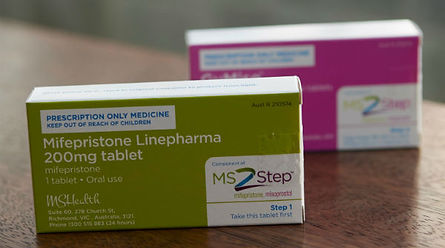The Abortion Pill for Medical Abortion ~ everything you need to know
Medical Termination of Pregnancy Using Mifepristone and Misoprostol (aka "The Abortion Pill")

If you are considering a medical abortion, it is important that you read this information carefully.
Please feel free to ask any questions that you might have about this information or any part of the process of a medical termination via the contact form at the bottom of the page, or just give us a call. We're here to help.
Medicines used for a Medical Abortion
There are two drugs that are used for a medical termination of a pregnancy. The first one is Mifepristone, and then between 24 and 48 hours after taking the Mifepristone, you will need to take some Misoprostol tablets.
Mifepristone blocks the effects of progesterone, which is a hormone that is needed for a pregnancy to continue.
Misoprostol is a prostaglandin medication, and it works by softening the cervix and making the womb contract to push out the pregnancy tissue.
In this way, Mifepristone and Misoprostol work together to end a pregnancy.

For more information about the medication, click here to read the consumer information leaflet (which are inside the packs)
A medical termination may not be possible or might not be a good option for you if:
-
you are pregnant and might wish to continue with your pregnancy
-
your pregnancy is assessed as being of more than 63 days duration
-
you have a known or suspected ectopic pregnancy (a pregnancy outside of the womb)
-
you have known or suspected bleeding disorder
-
you are taking blood thinning medications (anticoagulants)
-
you are regularly taking steroid treatment (eg. for arthritis or asthma or any other illness that requires steroid medicines).
-
your adrenal glands do not work very well
-
you have a known allergy to Mifepristone, Misoprostol or prostaglandins
-
you have an intrauterine contraceptive (IUD) still in the womb
-
you have an infection in the womb or fallopian tubes
-
you are already quite anaemic
Before you are given any Medicines
-
We recommend that you first take our suitability test to ensure that it is safe for you to have a tele-abortion.
-
You will need to have an ultrasound examination.
After initial investigations, the pregnancy is assessed as intrauterine and up to 63 days duration and we confirm that a medical termination is suitable for you, then you should be able to start the treatment.
You will also be offered screening for Chlamydia, which is a fairly common sexually transmitted infection.
There are two parts to the process of medical termination

The first step
You will take a single tablet of Mifepristone.
Some women will get some bleeding and cramping after the mifepristone between the first and second steps of the treatment.
If this happens, it is not a problem, but if you are worried, please call the MS Health 24-hour nurse after-care telephone service on 1300 515 883 or Clinic 66.
The second step
The next part of the treatment is to take Misoprostol tablets. Plan for a very quiet day when you are going to take the Misoprostol tablets, and have someone with you who can provide support and assistance if needed.
You will need to take the Misoprostol tablets between 24 and 48 hours after you took the Mifepristone tablet. We recommend you do this mid morning.

This second step can be quite uncomfortable. Take some pain-relief tablets, such as Panadeine Forte or Paracetamol/Ibuprofen combination, at least 45 minutes before you intend to start taking the Misoprostol tablets.
You will need to take a total of four Misoprostol tablets, and there are a few ways that you can do this:
You can take all four tablets at once
OR
You can take two tablets, wait an hour and then take the other two tablets. Your doctor will help you plan how to take the tablets.
It is preferable that Misoprostol tablets be taken by holding the tablets in your mouth, between the cheek and gum for 30 minutes. This is known as “buccal“ administration .
Any fragments of tablets left after 30 minutes can be swallowed with a glass of water. This method of taking the tablets has been shown to be the most effective.

After this, you can expect some vaginal bleeding, cramps and to pass some pregnancy tissue. This commonly happens within four hours, but in some cases may occur anywhere between 30 minutes and 48 hours after taking the second step - Misoprostol tablets.
The bleeding lasts on average for 10 to 16 days and may be heavy, particularly in the first day or so.
Most women require no further medication. However, if no bleeding has occurred within 24 hours after taking the Misoprostol, you should contact us as soon as possible.
A doctor may then ask you to take a second dose of Misoprostol, and have this dispensed or posted to you.
Signs & Symptoms of Termination
The information that follows lists the most common symptoms you may experience as part of the medical termination process. It is important to understand these symptoms and any risks that may arise from using this treatment.
Vaginal Bleeding
Sometimes bleeding can occur after taking the Mifepristone, before taking the Misoprostol, but not always.
If no bleeding occurs after the first step, it usually begins within 4 hours of taking the misoprostol tablets.
Bleeding can range from light to quite heavy, and is usually more than a typical menstrual period. It should reduce once the pregnancy is expelled.
The bleeding lasts on average for 10 to 16 days. Light bleeding can continue for 30 days or more, but does not normally go beyond the first menstrual period following your treatment.
Vaginal bleeding does not mean that the pregnancy has been expelled. A follow-up assessment is necessary to confirm the pregnancy has been terminated.
The 3 week check is very important. If you have pregnancy tissue left behind and don’t know about it, you could become unwell. We will assess you using your follow up blood test and then speak with you to hear what happened.

It is concerning if you saturate two or more sanitary maxi-pads per hour for two consecutive hours.
If you experience bleeding that seems to be too heavy or are at all concerned about the amount of bleeding you are experiencing, then you should contact the MS Health 24-hour Nurse After-care Telephone Service on 1300 515 883.

Cramping
Cramping usually starts quite soon after taking the Misoprostol tablets (second step) and will generally start within 4 hours of taking the tablets.
Cramping can range from mild to severe and is usually more than you would experience in a typical menstrual period.
Significant cramping should subside once the pregnancy is expelled from the uterus and does not usually last longer than 24 hours.
To help control your pain you should:
-
Not plan to do anything active or outside the home.
-
Try to move, stand and walk around
-
Use a hot pack on your lower abdomen or back
-
Massage your lower abdomen
-
Take pain relief medications. .

Other possible side-effects:
Sometimes the medical termination treatment can cause headaches, breast tenderness, fainting, hot flushes, skin rashes or itching.
Misoprostol tablets can cause nausea, vomiting, diarrhoea, dizziness, pain or discomfort in the abdomen, cramps, fever and chills.
These side effects are usually experienced for only a short time and should not last more than 24 hours.
If you experience problems or are at all concerned about side-effects you should contact the MS Health 24-hour Nurse After-care Telephone Service on 1300 515 883.
Possible adverse effects of the treatment
Although cramping and bleeding are expected as part of ending a pregnancy, occasionally (but rarely), serious and potentially life-threatening bleeding, infections or other problems can occur following a medical abortion. The use of this treatment is not risk free.
You should get immediate advice or seek medical attention if you experience:
-
Heavy vaginal bleeding: Soaking two or more sanitary maxi-pads per hour for two consecutive hours or passing large, fist-sized clots.
-
Prolonged heavy bleeding: It is expected that on average, bleeding will go on for 10 to 16 days after a medical termination and may initially be quite heavy. You should be seen by a doctor for any bleeding that continues for more than four weeks.
-
Severe cramping or abdominal pain which is not improved by pain-relief medication.
-
A fever or chills that last for more than 6 hours.
-
Any abnormal vaginal discharge.
-
Feeling sick with weakness, fatigue, nausea, vomiting, or diarrhoea more than 24 hours after taking the Misoprostol tablets.
You should also get medical advice if you are worried about an ongoing headache, breast tenderness, fainting, hot flushes or a skin rash.
Other side-effects may be possible, so if you think that you have developed a problem related to your treatment, you should contact the MS health 24-hour Nurse After-care Telephone Service on 1300 515 883.

Follow up
It is extremely important that you attend any appointments that you have been advised to complete.
Follow-up is essential to confirm that the termination of pregnancy is successful. If the termination is not complete, we will discuss what you need to do next.
It is strongly recommended that you do not plan to travel during the time that you are bleeding so that you can seek medical attention if necessary.
Contraception
You should use effective contraception until you are ready to have a child. We can provide advice to you about best options and even give you a prescription. Find out more >>>
It is important that you...
-
Tell us if you feel that something has been overlooked in your care.
-
Explain any safety concerns or any circumstances that could make your health care riskier.
-
Respect the rights of other patients and staff by conducting yourself in an appropriate way.
-
Respect the property of the clinic and of other patients.
-
Are honest, open and accurate with your health history.
-
Ask questions if you need more information or do not understand any aspect of your care.
-
Take an active role in your care and also follow your treatment plan.
-
Tell staff if you can't or won't be able to comply with your treatment plan.
